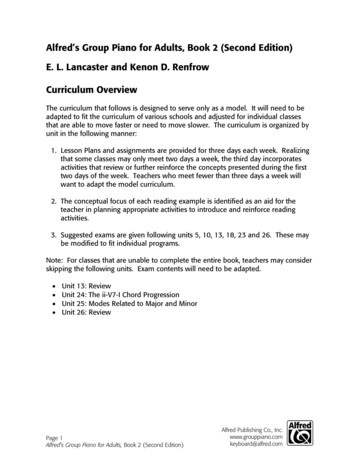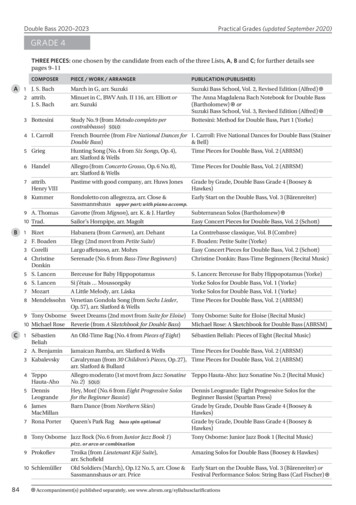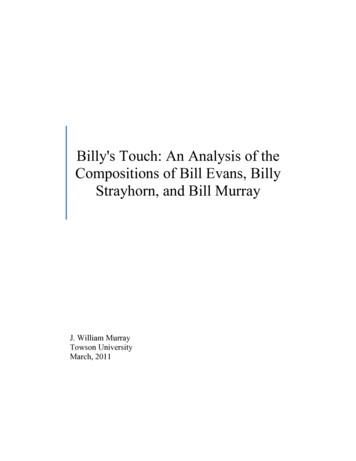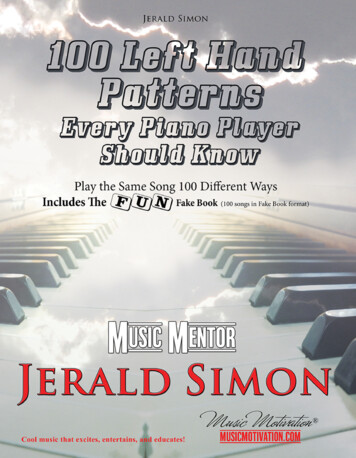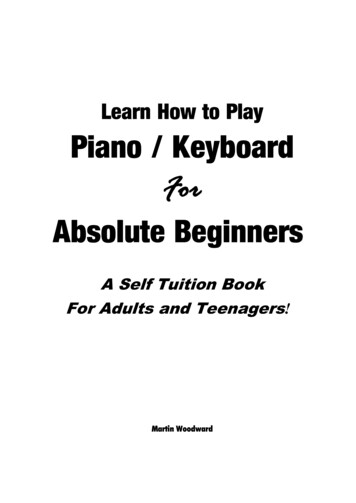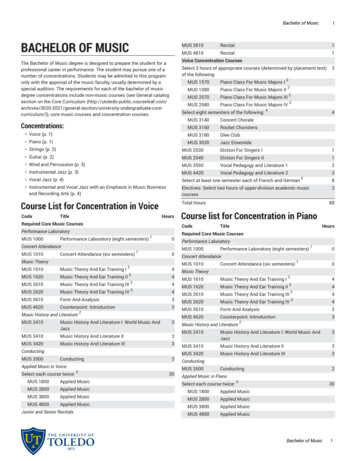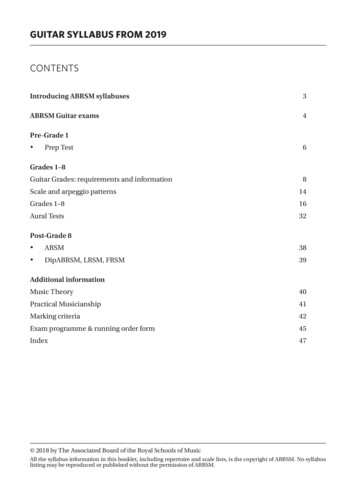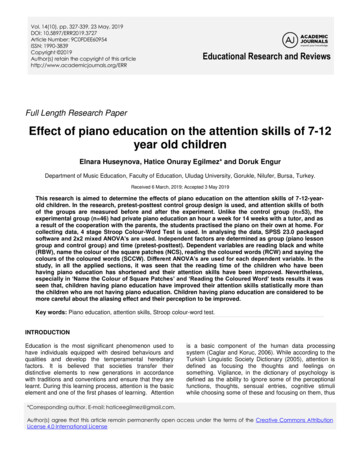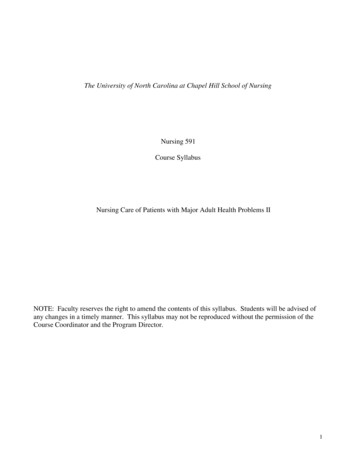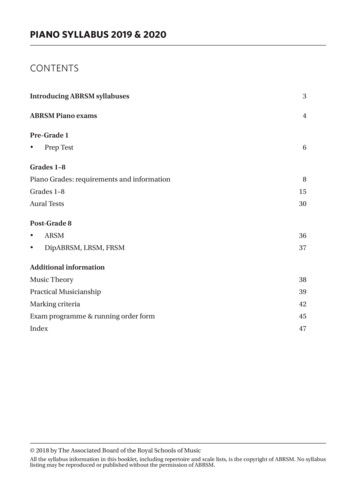
Transcription
PIANO SYLLABUS 2019 & 2020CONTENTSIntroducing ABRSM syllabuses3ABRSM Piano exams4Pre-Grade 1 Prep Test6Grades 1–8Piano Grades: requirements and information8Grades 1–815Aural Tests30Post-Grade 8 ARSM36 DipABRSM, LRSM, FRSM37Additional informationMusic T heory38Practical Musicianship39Marking criteria42Exam programme & running order form45Index47 2018 by T he Associated Board of the Royal Schools of MusicAll the syllabus information in this booklet, including repertoire and scale lists, is the copyright of ABRSM. No syllabuslisting may be reproduced or published without the permission of ABRSM.
2
INTRODUCING ABRSM SYLLABUSESAt ABRSM we are passionate about music and aim to support students and teachers in every waywe can. One way we do this is through our graded music exams. T hese assessments provide cleargoals, reliable and consistent marking, and guidance for future learning. T hey are a tried andtested way to inspire musical achievement and, with backing from four Royal Schools of Musicin the UK, are valued and trusted around the world.We offer graded music exams for a range of instruments (including singing) and genres, as wellas for Music T heory and Practical Musicianship. T he syllabuses are based on core musical skills– listening, performing, reading, writing, and musical knowledge and understanding. Togetherthese skills give students a good foundation for their musical development and a range ofdifferent musical activities.Taking an exam is an exciting challenge with many benefits for students. T here’s the boost tomotivation which comes from working towards an exam. T here’s an opportunity to discoverand perform some fantastic music and to build new skills. And there’s the sense of achievementwhich comes from successfully reaching a musical goal.We do everything we can to make the exam experience positive and rewarding. We work closelywith specialists, teachers and examiners to provide syllabuses of the highest quality with a widevariety of pieces and songs to choose from. We train our friendly, expert examiners to helpcandidates do their best in their exams. Using our clear, easy-to-understand marking criteriaexaminers can assess all candidates reliably, objectively and consistently. Finally, candidatesreceive a mark form containing valuable feedback, with a celebratory certificate for everyonewho passes.Whether you’re a student or teacher, we hope this syllabus inspires and supports your musiclearning or teaching. We wish you every success for your musical journey!Find out more at www.abrsm.org.3
ABRSM PIANO EXAMST his syllabus booklet is designed to help teachers, candidates, parents and organizations whenpreparing for ABRSM graded Piano exams.T he Piano syllabus is listed, grade by grade, on pp. 15–29 and shows the requirements for theexams. Important additional information can be found on pp. 8–13. T he Aural tests featured inall ABRSM graded exams are described on pp. 30–35. In addition, this booklet outlines ABRSM’spre-Grade 1 and post-Grade 8 piano assessments as well as the supporting subjects of MusicT heory and Practical Musicianship which contribute to all-round musical development.As well as reading this booklet, it is important to consult ABRSM’s Exam Regulations, availableat www.abrsm.org/examregulations.2019 & 2020 Piano syllabusT his booklet is valid for graded exams from 1 January 2019 to 31 December 2020.T here are new set pieces.All other requirements – Scales and arpeggios, Sight-reading and Aural tests – remain unchangedfrom the preceding syllabus.Any updates during this syllabus’s lifetime – e.g. changes to publication details or other minorcorrections or clarifications – will be posted at www.abrsm.org/syllabuscorrections.Overlap of syllabusesIn the first year of any new Practical syllabus, ABRSM offers an overlap period in whichcandidates may play specific requirements from the preceding syllabus.Information on the overlap duration and the specific requirements to which the overlap periodapplies can be found at www.abrsm.org/overlap.T he next syllabusT he next edition of this booklet will be published in 2020 and will take effect from 2021. Advancenotice of any planned changes to the Piano requirements from 2021 (including syllabus overlapinformation) will be posted in advance at www.abrsm.org/piano.Other assessments for PianoABRSM’s other Piano assessments are the Prep Test (see p. 6), Jazz Piano, PerformanceAssessment, Ensembles and diplomas (see pp. 36–37). Further information is available at www.abrsm.org/exams.4
ABRSM Piano examsRegulation and UCAS points (UK)ABRSM graded music exams and diplomas are regulated in England by the Office ofQualifications and Examinations Regulation (Ofqual) and the corresponding regulatoryauthorities in Wales (Qualifications Wales) and Northern Ireland (CCEA Regulation). T hey arepart of the Regulated Qualifications Framework (RQF) in England and Northern Ireland.In the UK, ABRSM’s Grade 6–8 exams can contribute towards entry into higher educationthrough the allocation of UCAS points.For further information, see www.abrsm.org/regulation.5
PIANO PREP TESTABRSM’s Prep Test, presented in a relaxed and encouraging way, is an ideal introduction to theexam experience. It gives students a goal to work towards and a certificate awarded on the day –something to be really proud of.T he Prep Test is designed to encourage the development of good musical and technical foundations. It covers many of the elements beginners will be working on at this early stage, includingpitch, time, tone, performance and musical perception.ContentT he Piano Prep Test consists of four sections – Tunes, two Pieces, and Listening Games: TunesThree short exercises played from memory:a) Cracking Open a Nut Ó Piano Prep Test bookb) Swinging T hrough the TreesÏ c) DreamingFirst Piece (solo)Any one of:Train Ride (Sarah Watts) Summer Fair (Nicholas Scott-Burt) Ó Piano Prep Test bookÏOn a Bike (Christopher Norton) orOne solo piece from any of these books: Piano Star 2Michael Rose: Party Time! for PianoAlan Bullard: Party Time! on HolidayAlan Haughton: RoundaboutSecond Piece (solo or duet)Own-choice solo piece (c.16–24 bars)orEither of the following duets: My Brass Band (Alan Bullard) Piano Prep Test book Jelly Wobble (Nikki Iles)orAny duet from:Piano Star 2Listening Games*Four listening games:a) Clapping the beatb) Echoesc) Finding the notesd) What can you hear? Ó examples are provided in theÏ Piano Prep Test book * For deaf or hearing-impaired candidates, further information is available at www.abrsm.org/specificneeds.6
Piano Prep TestAll the books mentioned on p. 6 are published by ABRSM and are available from music retailersas well as online, including at the ABRSM music shop: www.abrsm.org/shop.AssessmentImmediate feedback is given on the day, in the form of positive comments and suggestionswritten on the certificate, which is handed to the candidate by the examiner at the end of thePrep Test. T here is no pass or fail, and no marks are awarded. T he examiner’s comments willcover some of the following: Sense of pitchSense of rhythmControl of toneListening skills and awarenessOther information T he Prep Test takes about 10 minutes. At the start, candidates are welcome to adjust the piano stool height (the examiner will behappy to help with this) and to play a few notes to try out and get used to the piano. For typesof piano, see ‘Instruments’ on p. 8. T he Tunes should be performed from memory, but the two Pieces can be played from themusic. If either of the Pieces is played from memory, candidates should bring a copy of themusic for the examiner. If choosing to play a duet for the Second Piece, candidates can bring their own duet partner,but if not, the examiner will be happy to play the other part. Generally, there will be one examiner, although sometimes a second examiner may also bepresent. Details of dates, venues, fees and how to book a Prep Test are available online at www.abrsm.org/exambooking.7
PIANO GRADES: requirements and informationT his section provides a summary of the most important points that teachers and candidates needto know when taking ABRSM graded Piano exams. Further details, as well as administrativeinformation relating to the exams, are given in ABRSM’s Exam Regulations (available at www.abrsm.org/examregulations) which should be read before an exam booking is made.Entering for an examEligibility: T here are eight grades of exam for Piano and candidates may be entered for any gradeirrespective of age and without previously having taken any other grade in Piano. Candidates fora Grade 6, 7 or 8 exam must already have passed ABRSM Grade 5 (or above) in Music Theory,Practical Musicianship or a solo Jazz instrument; for full details, including a list of acceptedalternatives, see www.abrsm.org/prerequisite.Access: ABRSM endeavours to make its exams as accessible as possible to all candidates,regardless of sensory impairments, learning difficulties or particular physical needs. T here is arange of alternative tests and formats as well as sets of guidelines for candidates with particularaccess needs (see www.abrsm.org/specificneeds). Where a candidate’s needs are not covered bythe guidelines, each case is considered on an individual basis. Further information is availablefrom the Access Co-ordinator (accesscoordinator@abrsm.ac.uk).Exam booking: Details of exam dates, locations, fees and how to book an exam are availableonline at www.abrsm.org/exambooking.InstrumentsABRSM Centres provide a piano suitable for exam purposes. T he piano will be upright or grand.Practice before the exam cannot be arranged, but examiners will recognize that the instrumentmay be one to which candidates are unaccustomed. When exams are held at Visits (i.e. premisesprovided by the Applicant and visited by the examiner), a suitable piano must be provided.A digital piano may be used, provided it has a clearly recognizable piano tone, a touch-sensitivekeyboard with full-size weighted keys, and an action, compass and facilities that match those ofa conventional acoustic piano, including a sustaining pedal.Elements of the examAll ABRSM graded Piano exams comprise the following elements: three Pieces; Scales andarpeggios/broken chords; Sight-reading; and Aural tests. In all grades, marks are allocated asfollows:Pieces: 123Scales and arpeggios/broken chordsSight-readingAural testsTotal8303030212118150
Piano grades: requirements and informationMarking scheme: 100 marks are required for a Pass, 120 for a Merit and 130 for a Distinction.A Pass in each individual section is not required to pass overall. See pp. 42–43 for the markingcriteria used by examiners.PiecesProgramme planning: Candidates must choose one piece from each of the three lists (A, B andC) in each grade. In the exam, they should inform the examiner which pieces they are performing,and they are welcome to use the form on p. 45 for this purpose.Every effort has been made to ensure the syllabus lists feature a broad range of repertoire, withitems to suit and appeal to candidates of differing ages, backgrounds and interests. Not everypiece will be suitable for every candidate due to technical reasons (e.g. hand size) or widercontext (historical, cultural, subject matter of the larger work from which it is drawn, lyrics if anarrangement of a song etc.). It is advised that pieces selected are considered carefully for theirappropriateness to each individual, which may require consultation between teachers andparents/guardians. Given the ever-changing nature of the digital world, teachers and parents/guardians should also exercise caution when allowing younger candidates to research itemsonline: www.nspcc.org.uk/onlinesafety.Exam music & editions: Wherever the syllabus includes an arrangement or transcription, theedition listed in the syllabus must be used in the exam; in all such cases the abbreviation ‘arr.’ or‘trans.’ appears in the syllabus entry. For all other pieces, the editions quoted in the syllabus aregiven for guidance only and candidates may use any edition of their choice (in- or out-of-printor downloadable). Information on obtaining exam music is given on p. 13.Interpreting the score: Printed editorial suggestions such as fingering, metronome marks,realization of ornaments etc. need not be strictly observed. Whether the piece containsmusical indications or not, candidates are always encouraged to interpret the score in a stylisticallyappropriate manner. Ultimately, examiners’ marking will be determined by consideration ofpitch, time, tone, shape and performance, and how control of these contributes to the overallmusical outcome.Pedalling: T he use and control of pedalling, and its effect on tone and shape, will be taken intoaccount by examiners, who will be assessing the overall musical outcome rather than the strictobservance of any printed pedal indications (which may therefore be adapted or omitted, asappropriate). Pieces whose full musical effect is heavily reliant on pedalling (whether marked inthe music or not) should be avoided if appropriate pedalling cannot be managed.Hand stretch: Candidates should choose the most suitable pieces for their hand size from thesyllabus lists. If necessary, they may occasionally adapt the music by ‘spreading’ chords or omitting notes at wide stretches, provided the result is musically satisfactory.Repeats: All da capo and dal segno indications should be observed but all other repeats(including first-time bars) should be omitted unless they are very brief (i.e. of a few bars) orunless the syllabus specifies otherwise.Performing from memory: Candidates are free to perform any of their pieces from memory;in such cases they must ensure that a copy of the music is available for the examiner to refer to ifnecessary. No additional marks are awarded for playing from memory.9
Piano grades: requirements and informationPage-turns: Examiners will be understanding if a page-turn causes a lack of continuity during apiece, and this will not affect the marking. A variety of solutions for awkward page-turns exists,including the use of an additional copy of the music or a photocopy of a section of the piece (butsee ‘Photocopies’ below). In cases where candidates at Grades 6–8 believe there is no solution toa particularly awkward page-turn, they may bring a page-turner to the exam (prior permissionis not required; the turner may be a candidate’s teacher). Examiners are unable to help withpage-turning.Photocopies: Performing from unauthorized photocopies (or other kinds of copies) of copyrighteditions is not allowed. ABRSM may withhold the exam result where it has evidence of an illegalcopy (or copies) being used. In the UK, copies may be used in certain limited circumstances –for full details, see the MPA’s Code of Fair Practice at www.mpaonline.org.uk. In all other cases,application should be made to the copyright holder before any copy is made, and evidence ofpermission received should be brought to the exam.Scales and arpeggios/broken chordsExaminers will usually ask for at least one of each type of scale/arpeggio/broken chord etc.required at each grade and will ask for majors followed by minors within each type. T hey will alsoask to hear a balance of the hand requirements and, in Grades 6–8, of the specified articulationsacross the requests as a whole. When asking for requirements, examiners will specify: the key (including minor form – harmonic or melodic – in the Grade 6–8 scales) or thestarting noteleft hand or right hand, or hands togetherthe articulation (where chosen by the examiner)All scales, arpeggios and broken chords should: be played from memorybe played in even notes (with the exception of the Grade 1 broken-chord pattern)ascend and descend according to the specified range (and pattern)be prepared legato, unless the syllabus specifies staccato (or both)be played without pedallingCandidates are welcome to use any fingering that produces a successful musical outcome.Candidates are free to start at any octave, provided the required ranges are covered. For all ‘handstogether’ requirements, the hands should be one octave apart, unless otherwise indicated.Arpeggios and dominant sevenths are required in root position only, except where otherwiseindicated. Scales in thirds or a third apart should begin with the tonic as the lower note, whilescales in sixths or a sixth apart should begin with the tonic as the upper note.Books of the requirements are published for Piano by ABRSM for each grade.10
Piano grades: requirements and informationT he following speeds are given as a general guide:Grade / Speed*12345678Scales (incl. contrary-motion,q 60chromatic & whole-tone)q 66q 80h 52h 63h 76h 80h 88Arpeggios (incl. brokenchords, dom. & dim. 7ths)q 63q 69q 76q 88h 50h 56h 66Scales in 3rds h 52h 46h 52Scales a 3rd apart h 60h 63q. 46Scales in 6ths / a 6th apart h 52h 63Chromatic scales ah 76minor 3rd apartChromatic scale inminor 3rdsh 52(continued overleaf )* All speeds relate to the rhythmic grouping q q q q , except for broken chords in Grade 1, where q q q applies.11
Piano grades: requirements and informationSight-readingCandidates will be asked to play a short unaccompanied piece of music which they have notpreviously seen. T hey will be given half a minute in which to look though and, if they wish,try out all or any part of the test before they are required to play it for assessment. T he tablebelow shows the introduction of elements at each grade. Please note that these parameters arepresented cumulatively, i.e. once introduced they apply for all subsequent grades (albeit withina logical progression of difficulty).For practice purposes, books of sample sight-reading tests are published for Piano by ABRSMfor each grade.Grade Length(bars)146Time KeysHand positionOther features that may be included4/43/4C, G, F majorsA, D minorsEach hand: playing separately in 5-fingerpositionSimple: dynamics note values articulationsOccasional accidentals (withinminor keys only)D majorE, G minorsHands playingtogether dotted notes tied notes 2-note chords in either hand2/423up to 83/84c. 86/85c. 8–12A, Bb, Eb majors Hands playingB minortogether outside5-finger positionE, Ab majorsF#, C minors6c. 12–169/85/85/47c. 16–207/87/48c. 1 page12/8C#, F minorsB, Db majors anacrusischromatic notespause signstenuto4-part chords (2 notes max. ineither hand)simple syncopationslowing of tempo at endtriplet rhythmsclef changesuse of right pedaltempo changes8va signuse of una corda pedal3-part chords in either handspread chordssimple ornamentsAural testsT he requirements are the same for all subjects. Full details of the Aural tests are given on pp.30–35.12
Piano grades: requirements and informationIn the examExaminers: Generally, there will be one examiner in the exam room; however, for training andquality assurance purposes, a second examiner may sometimes be present. Examiners may askto look at the music before or after the performance of a piece (a separate copy is not required:the candidate’s copy will suffice). Examiners may stop the performance of a piece when theyhave heard enough to form a judgment. T hey will not issue or discuss a candidate’s result;instead, the mark form (and certificate for successful candidates) will be issued by ABRSM afterthe exam.Before beginning: Candidates are welcome to adjust the piano stool height (the examiner will behappy to help with this if necessary) and to play a few notes to try out and get used to the piano.Order of the exam: T he individual sections of the exam may be taken in any order, at thecandidate’s choice.AssessmentT he tables on pp. 42–43 show the marking criteria used by examiners. In each element of theexam, ABRSM operates the principle of marking from the required pass mark positively ornegatively, rather than awarding marks by deduction from the maximum or addition from zero.In awarding marks, examiners balance the extent to which the qualities and skills listed on pp.42–43 (broadly categorized by pitch, time, tone, shape and performance) are demonstrated andcontribute towards the overall musical outcome.Obtaining exam musicExam music is available from music retailers as well as online, including at the ABRSM musicshop: www.abrsm.org/shop. Every effort has been made to ensure that all the publications listedwill remain available for the duration of the syllabus. Candidates are advised to obtain their musicwell in advance of the exam in case of any delays with items not kept in stock by retailers. Apartfrom queries relating to exams, all enquiries about the music (e.g. editorial, availability) shouldbe addressed to the relevant publisher: contact details are listed at www.abrsm.org/publishers.13
NOTES14
Piano 2019& 2020Piano 2019& 2020GRADE 1THREE PIECES: one chosen by the candidate from each of the three Lists, A , B and C:COMPOSERA12345123456C1PUBLICATION (PUBLISHER)Theme (from Theme and Variations, SonatinaNo. 4 in D)DuncombeMinuet in C (from First Book of ProgressiveLessons)Anon. English Agincourt Song, arr. HammondW. F. BachAir in A minorHaydnQuadrille6 TürkBPIECE / WORK / ARRANGERAttwoodA Lovely DayWiegenlied (No. 4 from Five Songs, Op. 49),arr. LittenOestenThe Echo (No. 14 from Mayflowers, Op. 61)SwinsteadThe Lonely Road (No. 6 from Work and Play)BartókQuasi adagio (No. 3 from For Children, Vol. 1)Andrew Eales Head in the CloudsAndrew Lloyd Close every door (from Joseph and the AmazingWebberTechnicolor Dreamcoat), arr. BullardBrahmsIan King2 J. M. Last3 KevinPiano Exam Pieces 2019 & 2020, Grade 1 (ABRSM)Piano Exam Pieces 2019 & 2020, Grade 1 (ABRSM)Piano Exam Pieces 2019 & 2020, Grade 1 (ABRSM)The Joy of First Classics, Book 2 (Yorktown Music Press)Classics to Moderns, Book 1 (Yorktown Music Press) orPathways to Artistry: Masterworks Book 2 (Alfred)Pathways to Artistry: Masterworks Book 2 (Alfred)Piano Exam Pieces 2019 & 2020, Grade 1 (ABRSM)Piano Exam Pieces 2019 & 2020, Grade 1 (ABRSM)Piano Exam Pieces 2019 & 2020, Grade 1 (ABRSM)Bartók: For Children, Vol. 1 (Boosey & Hawkes)Piano Star 3 (ABRSM)The Graded Piano Player, Grades 1–2 (Faber)Happy DayWho Said Mice? (from Cats)The Egyptian LevelPiano Exam Pieces 2019 & 2020, Grade 1 (ABRSM)Piano Exam Pieces 2019 & 2020, Grade 1 (ABRSM)Piano Exam Pieces 2019 & 2020, Grade 1 (ABRSM)In the Scrum (from Cool Piano Sport,Grade 1–2)Gospel Song (No. 2 from On the Lighter Side:16 Pieces for Solo Piano) with straight quavers;Heather Hammond: Cool Piano Sport, Grade 1–2(Kevin Mayhew)John Kember: On the Lighter Side: 16 Pieces forSolo Piano (Schott)The Witch (No. 7 from Hansel & Gretel)S. Wilson: Hansel & Gretel (Forsyth)Wooding4 HeatherHammond5 John Kemberobserving alternative ending6 S. WilsonSCALES AND BROKEN CHORDS: from memory; for further details see page 10 RANGEREQUIREMENTS2 oct.hands separately (LH may be played descending andascending at candidate’s choice)1 oct.hands beginning on the tonic (unison)SCALESC, G, D, F majorsA, D minors (natural or harmonic or melodic,at candidate’s choice)CONTRARY-MOTION SCALEC majorBROKEN CHORDSC, G, F majorsA, D minorsV 68 Š Š Š Š Š Š Š Š Š Š.hands separately, as pattern below:Š Š Š Š Š Š Š Š Š.ŠSIGHT-READING: a short piece of previously unseen music; for further details see page 12AURAL TESTS: administered by the examiner from the piano; for further details see pages 30 & 3115
Piano 2019 & 2020GRADE 2THREE PIECES: one chosen by the candidate from each of the three Lists, A , B and C:A1COMPOSERPIECE / WORK / ARRANGERPUBLICATION (PUBLISHER)DiabelliLesson in C (No. 10 from Die ersten 12Lektionen, Op. 125)Musette in D, BWV Anh. II 126Gigue à l’Angloise (6th movt from Partita in G,TWV 32:1)Arietta in F (from An Introduction to the Art ofPlaying on the Pianoforte)Air (Hornpipe) in D minor, HWV 461Allegro (4th movt from Sonata in G, Hob. XVI:8)Piano Exam Pieces 2019 & 2020, Grade 2 (ABRSM)2 Anon.3 Telemann4 Clementi5 Handel6 HaydnB1Piano Exam Pieces 2019 & 2020, Grade 2 (ABRSM)Piano Exam Pieces 2019 & 2020, Grade 2 (ABRSM)Clementi: The First Book for Young Pianists (Alfred)Handel: Easy Piano Pieces and Dances (Bärenreiter)Haydn: Selected Keyboard Sonatas, Book 1 (ABRSM)Arabesque (No. 2 from 25 études faciles etprogressives, Op. 100)Waltz (No. 13 from 24 Easy Pieces, Op. 39)Lazy Bear (from Piano Sketches, Book 1)Piano Exam Pieces 2019 & 2020, Grade 2 (ABRSM)With the Immortals (Forsyth)Music Through Time, Piano Book 1 (OUP)6 SomervellNel cor più, arr. FlyNight Journey (No. 65 from The First Steps ofthe Young Pianist, Op. 82)Plaintive Waltz (from Holiday Pictures)1Dusty Blue (from Paint Box)Piano Exam Pieces 2019 & 2020, Grade 2 (ABRSM)Ja-Da, arr. IlesPetite valse (from Lazy Days)A Memory of ParisRoyal March of the Lion (from The Carnival ofthe Animals), arr. LittenLazy Days (No. 7 from Up-Grade! PianoGrades 1–2)Piano Exam Pieces 2019 & 2020, Grade 2 (ABRSM)Piano Exam Pieces 2019 & 2020, Grade 2 (ABRSM)Gillock: Accents Around the World (Willis)Piano Mix 1 (ABRSM)Burgmüller2 Kabalevsky3 VitalijPiano Exam Pieces 2019 & 2020, Grade 2 (ABRSM)Piano Exam Pieces 2019 & 2020, Grade 2 (ABRSM)Neugasimov4 Beethoven5 GurlittC2345JuneArmstrongB. CarletonBrian ChappleGillockSaint-Saëns6 PamWedgwood16A Romantic Sketchbook for Piano, Book 1 (ABRSM)Pam Wedgwood: Up-Grade! Piano Grades 1–2 (Faber)
Piano 2019 & 2020 Grade 2SCALES, ARPEGGIOS AND BROKEN CHORDS: from memory; for further details see page 10 RANGEREQUIREMENTS2 oct.hands together or separately, as chosen by theexaminer2 oct.hands beginning on the tonic (unison)1 oct.hands separately2 oct.hands separately2 oct.hands separately, as pattern below:SCALES (SIMILAR MOTION)G, D, A, F majorsE, D, G minors (natural or harmonic or melodic,at candidate’s choice)CONTRARY-MOTION SCALESC, E majorsCHROMATIC SCALEbeginning on DARPEGGIOSG, D, A majorsD, G minorsBROKEN CHORDSF majorE minorVb Š Š Š Š Š Š Š Š Š Š Š Š Š Š Š Š Š Š Š Š Š Š Š Š Š Š Š Š Š Š Š ŠSIGHT-READING: a short piece of previously unseen music; for further details see page 12AURAL TESTS: administered by the examiner from the piano; for further details see pages 30 & 3117
Piano 2019 & 2020GRADE 3THREE PIECES: one chosen by the candidate from each of the three Lists, A , B and C:COMPOSERA61W. Carroll2345BHook2 Gurlitt3 Reinecke4 L. Cohen5 Martha Mier6 TchaikovskyCPIECE / WORK / ARRANGERAllegro (1st movt from Sonatina in F,Op. 12 No. 3)SeixasGiga (2nd movt from Sonata in D minor)M. Praetorius Bransle de la torche (from Terpsichore), arr. PellDittersdorfEnglish Dance in B - (No. 9 from 20 englischeTänze)HaydnGerman DanceMozartMenuett in F, K. 511Bartók2 R. R. Bennett3 Nikki Iles4 JunePUBLICATION (PUBLISHER)Piano Exam Pieces 2019 & 2020, Grade 3 (ABRSM)Piano Exam Pieces 2019 & 2020, Grade 3 (ABRSM)Piano Exam Pieces 2019 & 2020, Grade 3 (ABRSM)Dittersdorf: 20 englische Tänze (Schott)The Joy of First Classics, Book 2 (Yorktown Music Press)Mozart: 25 Early Pieces (ABRSM)Shadows (No. 3 from River and Rainbow)Allegretto grazioso (No. 11 from Kleine Blumen,Op. 205)Prelude (1st movt from Serenade in C,Op. 183 No. 1)Hallelujah, arr. MillerThistles in the WindOld French Song (No. 16 from Album for theYoung, Op. 39)Piano Exam Pieces 2019 & 2020, Grade 3 (ABRSM)Piano Exam Pieces 2019 & 2020, Grade 3 (ABRSM)Dance (No. 8 from For Children, Vol. 2)Diversion (No. 1 from Diversions)Blues in the AtticUnicorn (from Stars)Piano Exam Pieces 2019 & 2020, Grade 3 (ABRSM)Piano Exam Pieces 2019 & 2020, Grade 3 (ABRSM)Piano Exam Pieces 2019 & 2020, Grade 3 (ABRSM)June Armstrong: Stars (Pianissimo Publishing)Wouldn’t it be Loverly? (from My Fair Lady),arr. Bullard observing triplets in bb. 12 & 18Face in the Crowd (No. 25 from The MicrojazzPiano Collection 2)The Graded Piano Player, Grades 2–3 (Faber)Piano Exam Pieces 2019 & 2020, Grade 3 (ABRSM)A Dozen a Day Songbook, Book 2 (Willis)The Best of Martha Mier, Book 2 (Alfred)Tchaikovsky: Album for the Young, Op. 39 (ABRSM orPeters) orShort Romantic Pieces for Piano, Book 1 (ABRSM)Armstrong5 Lerner &Loewe6 ChristopherNorton18Christopher Norton: The Microjazz Piano Collection 2(Boosey & Hawkes)
Piano 2019 & 2020 Grade 3SCALES AND ARPEGGIOS: from memory; for further details see page 10 RANGEREQUIREMENTS2 oct.hands together or separately, as chosen by theexaminer2 oct.hands beginning on the tonic (unison)2 oct.hands separately2 oct.hands together2 oct.hands separatelySCALES (SIMILAR MOTION)A, E, B, B -, E - majorsB, G, C minors(harmonic or melodic, at candidate’s choice)CONTRARY-MOTION SCALESA majorA harmonic minorCHROMATIC SCALESbeginning on A beginning on CARPEGGIOSA majorG minorE, B, B -, E - majorsB, C minorsSIGHT-READING: a short piece of previously unseen music; for further details see page 12AURAL TESTS: administered by the examiner from the piano; for further details see pages 30 & 3219
Piano 2019 & 2020GRADE 4THREE PIECES: one chosen by the candidate from each of the three Lists, A , B and C:COMPOSERABeethoven2 Benda3 Telemann4 J. S. Bach15 Diabelli6 HaydnB1W. Carroll2 Grieg3 Elgar4 Grechaninov5 Kullak6 TchaikovskyC1Gillock2 RichardPIECE / WORK / ARRANGERPUBLICATION (PUBLISHER)Bagatelle in C, WoO 54Sonatina in A minorPetit jeu (from Fugues légères et petits jeux)Minuet (5th movt from French Suite No. 3 inB minor, BWV 814)Scherzo: Allegro (2nd movt from Sonatina in G,Op. 151 No. 1) observing repeatsFinale: Presto (3rd movt from Sonata in A,Hob. XVI:26)Piano Exam Pieces 2019 & 2020, Grade 4 (ABRSM)Piano Exam Pieces 2019 & 2020, Grade 4 (ABRSM)Piano Exam Pieces 2019 & 2020, Grade 4 (ABRSM)The Best of Grade 4 Piano (Faber)The Ricordi Sonatina Album (Ricordi)Haydn: Sonata in A, Hob. XVI:26 (Wiener Urtext) orHaydn: Complete Piano Sonatas, Vol. 3 (Wiener Urtext)The Reef (No. 5 from In Southern Seas)Arietta (No. 1 from Lyriske småstykker, Op. 12)Chanson de matin, Op. 15 No. 2, arr. BlackwellIn the
ABRSM PIANO EXAMS This syllabus booklet is designed to help teachers, candidates, parents and organizations when preparing for ABRSM graded Piano exams. The Piano syllabus is listed, grade by grade, on pp. 15–29 and shows the requirements for the exams. Important additional informat
